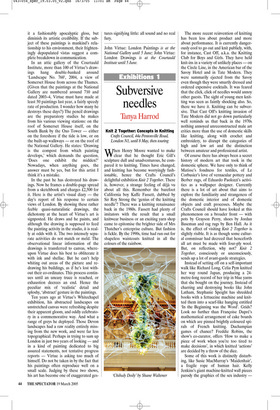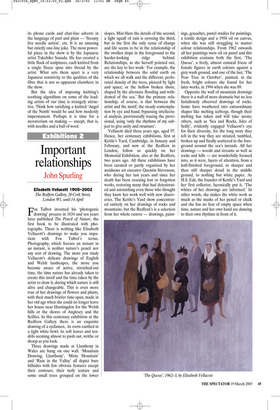Subversive needles
Tanya Harrod
Knit 2 Together: Concepts in Knitting Crafts Council, 44a Pentonville Road, London N1, until 8 May, then touring When Henry Moore wanted to make clear that he thought Eric Gill’s sculpture dull and unadventurous, he compared it to knitting. Times have changed, and knitting has become worryingly fashionable, hence the Crafts Council’s delightful exhibition Knit 2 Together. There is, however, a strange feeling of déjà vu about all this. Remember the barefoot California boy Kaffe Fassett, dubbed by Sir Roy Strong the ‘genius of the knitting needle’? There was a knitting renaissance back in the 1980s. Fassett had plenty of imitators with the result that a small knitwear business or an exciting yarn shop came to epitomise the brighter side of Mrs Thatcher’s enterprise culture. But fashion is fickle. By the 1990s, time had run out for shapeless waistcoats knitted in all the colours of the rainbow. The more recent reinvention of knitting has been less about product and more about performance. It is currently dangerously cool to go out and knit publicly, with, for instance, Cast Off, a.k.a. the Knitting Club for Boys and Girls. They have held knit-ins in a variety of unlikely places — on the Circle Line, in the American bar of the Savoy Hotel and in Tate Modern. They were summarily ejected from the Savoy even though they were smartly dressed and ordered expensive cocktails. It was feared that the click, click of needles would annoy other guests. The sight of young men knitting was seen as faintly shocking also. So, there we have it. Knitting can be subversive. That Cast Off’s knitting invasion of Tate Modern did not go down particularly well reminds us that back in the 1970s nothing annoyed unreconstructed male art critics more than the use of domestic skills like knitting, along with crochet and embroidery, to disrupt the categories of high and low art and the distinction between amateur and professional artist.
Of course there has always been a secret history of modern art that took in the domestic sphere. We have only to think of Matisse’s fondness for textiles, of Le Corbusier’s love of vernacular pottery and Berber rugs, of Eduardo Paolozzi’s activities as a wallpaper designer. Currently there is a lot of art about that aims to explore the familiarity and strangeness of the domestic interior and of domestic objects and craft processes. Maybe the Crafts Council should have looked at this phenomenon on a broader front — with pots by Grayson Perry, shoes by Jordan Baseman and rag rugs by Ben Hall. As it is, the effect of visiting Knit 2 Together is slightly risible. It is as though some cultural commissar had decreed that henceforth all art must be made with four-ply wool. But, on reflection, why not? Knit 2 Together, consciously or unconsciously, sends up a lot of avant-garde strategies.
Instead of setting off on a self-important walk like Richard Long, Celia Pym knitted her way round Japan, producing a 24metre-long record of her trip in blue yarns that she bought on the journey. Instead of charring and destroying books like John Latham, Stephanie Speight has shredded books with a fettuccine machine and knitted them into a scarf-like hanging entitled ‘In the Beginning was the Word’. Grids? Look no further than Françoise Dupré’s mathematical arrangement of cake boards on which are pinned brightly coloured spirals of French knitting. Duchampian games of chance? Freddie Robins, the show’s co-curator, offers ‘How to make a piece of work when you’re too tired to make decisions’, in which knitted ‘actions’ are decided by a throw of the dice.
Some of this work is distinctly disturbing, like Susie MacMurray’s ‘Maidenhair’, a fragile rope of human hair. Kelly Jenkins’s giant machine-knitted wall pieces parody the graphics of the sex industry — its phone cards and chat-line adverts in the language of purl and plain — ‘Steamy live needle action’, etc. It is an amusing but strictly one-line joke. The most powerful piece in the show is by the Japanese artist Takehiko Sanada. He has created a little flock of sculptures, each knitted from a single fleece spun into thread by the artist. What sets them apart is a very Japanese sensitivity to the qualities of the fibre that is not so apparent elsewhere in the show.
But the idea of imposing knitting’s soothing algorithms on some of the leading artists of our time is strangely attractive. Think how satisfying a knitted ‘Angel of the North’ would be and how modestly impermanent. Perhaps it is time for a moratorium on making — except, that is, with needles and a ball of wool.

















































 Previous page
Previous page